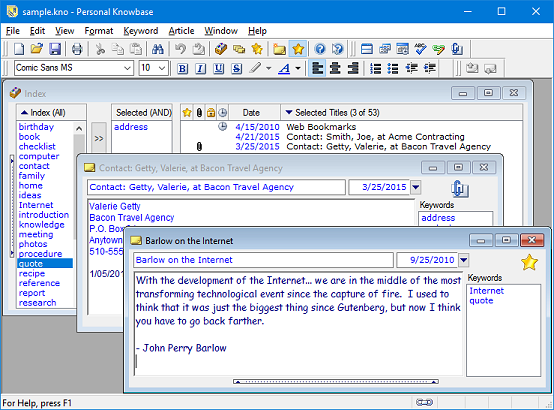Using Personal Knowbase as Index Card Software
Since the 1980's, we've been using personal computers to replace tasks that we used to do with pen and paper. We used paper index cards for many purposes from research to recipes. Now we put that information on our computer.
Although we now enter most information directly into our computers, the structure of the data often still resembles how index card systems used to work. We have digitized our index card projects.
Tasks that we once used paper index cards for that we now use software for include:
- Recipes
- Contact management
- Meeting and telephone notes
- Book reviews
- Bibliography
- Ideas dump
- Household inventory
- Tips, tricks, and cheats
- Collection inventories
- Travel information
- Quotations
- Research note cards
- And more...
Advantages of Digital over Paper Systems
Using digital index cards has many advantages over the original paper variety:
- indexing
- searching
- sorting
- easy editing
- flexible text length
On our old paper cards, we had lots of cross-outs and changes and had to flip the cards over to check for more information. If we used pencil, it smudged.
When we ran out of space, we had to transfer the information to multiple cards. Considerable re-writing ensued. With digital index cards, if we need to split a card, we simply cut-and-paste to move the text blocks without having to re-write.
We used to dig through boxes and boxes of index cards to find lost information. Now we can easily search computerized data.
Remember what happened if you dropped your card deck? Time was lost re-organizing and sorting the cards back into the correct order.
Personal Knowbase for Index Cards
Personal Knowbase's freeform note management software provides a flexible way to digitize your "index card" systems.
Create an index card system that allows you to reshuffle your cards alphabetically, by date, or based on any number of related subjects. There is no limit on the number of cards or length of card content. You can sort, print, search, index, filter, and more.
Personal Knowbase refers to each "index card" as an "article". In addition to its main text content area, each article has a title, date, time, and keywords list.

Tips for using Personal Knowbase for digital index cards:
1) Index Card Stacks
When assigning keywords to your PK articles, consider thinking of them as a way to create "stacks".
To simulate index card stacks, assign the same keyword to all related articles (cards). Select that keyword to see the titles of all cards in that "stack". Since you can assign any number of keywords to each article, each card can belong to any number of stacks.
Unlike with paper-based index cards, with Personal Knowbase you can place an article in multiple "stacks" and re-sort instantly. "Restack" articles on the fly by recombining keywords with combinations of AND, OR, and NOT using PK's Build Query command.
2) Dates for Articles
Each article has one date which is set to the current date on new articles. By default, this date is updated automatically each time you modify an article. If you are storing date-related information, you probably want to turn off this date auto-updating to avoid accidentally updating it with each little edit.
To turn it off, use the File Properties command from the File menu. In the File Properties dialog box, go to the Articles tab and remove the check mark for Automatically Update Article Dates.
3) Color in Article Content
The article content area allows extensive rich-text formatting, including fonts, color, highlighting, indenting, and bulleted lists. Use formatting to convey information about a card's content at a glance. For example, color some of an archived article's text gray to show that the information is outdated. Use a different color for research notes than for annotations. Use red for critical to-do items. And so on.
4) Cross-referencing Cards
The primary way to cross-reference cards in PK is by assigning common keywords to articles which may need to be referenced together.
If you need to directly cross-reference two cards, you can create a hypertext link from inside the text of one article to the other article.
Digital index cards save time, lack length limitations, can be inter-linked, and are easy to search.
The Windows Cardfile program used to provide a simple way to organize note cards, but Cardfile had many limitations and is not included with modern versions of Windows.
Personal Knowbase is a great alternative to paper index cards or Windows Cardfile. Create a new data file for each different project or data type. If you're not sure if PK will work for your needs, try our 30-day fully functional trial.
Search Site
Recent Posts
About
Personal Knowbase is a note management program for Windows. Organize free-form text information using keywords.
To see if Personal Knowbase is right for you, please download a fully-functional 30-day software trial.
Tags
attachments backup clipboard dates documentation education export files find formatting getting started import information management installation interface keywords network PK Reader portability print query registration reports research security settings site info small business support time management upgrade Windows writers